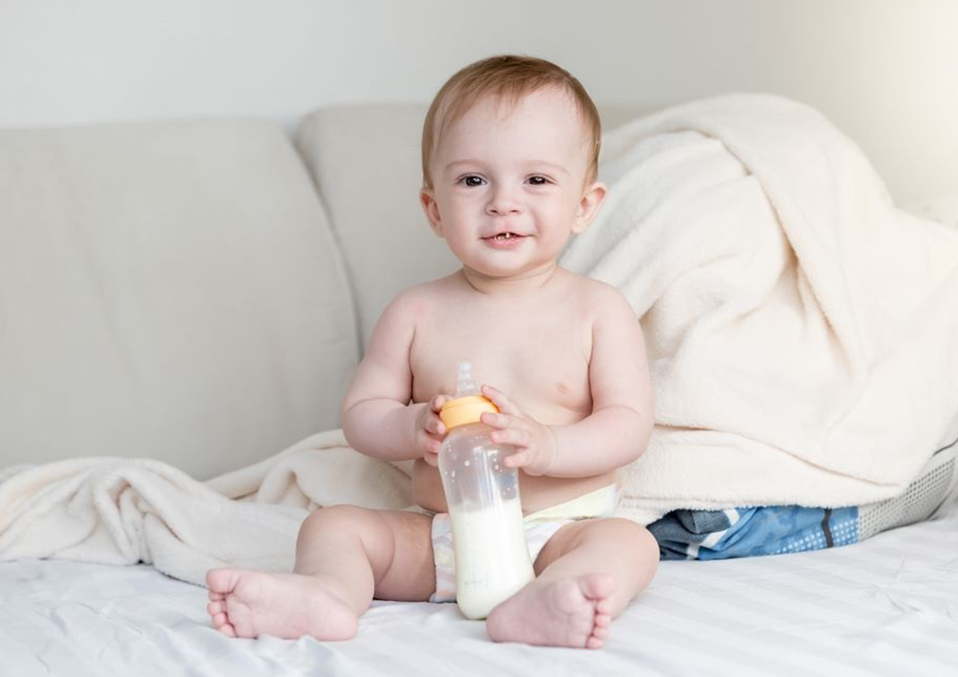According to the American Academy of Pediatrics baby bottle, the risk of ear infections also increases. If the baby is lying while feeding, fluid will flow from the mouth into the auditory tube, which can stay there and cause an infection.
Another important reason for not holding the bottle or letting it hold itself: it can rob the baby of important time to cuddle. Wrap the baby up to steer a sense of safety and promote binding.
Having the option to get your child to hold his very own jug is a major advance in his life. This is an achievement that you should be proud of, showing that your child is growing and developing their motor skills. Now and again a youngster needs some consolation and direction when he figures out how to hold his very own jug.
Your kid will get used to the moves. If you give your milk powder instead of breastfeeding, you can start to get used to the baby feeling the bottle for 2-3 months.
This will appeal to the right movement of the hand and the feeling of the bottle.
Of course, your kid’s too young to know what he’s doing.
8. Illustration Of a Child.
When the baby is 6 and 10 months old, encourage us to be in the bottle.
If you feel that they can hold onto the bottle firmly and tolerate the weight of their own (incessantly feeding), you can use the bottle for a short period of time. Some bottles are better for the baby’s hand than others.
7. Watch Out For Your Kid’s Motor Skills.
A decent method to decide whether your youngster is prepared to hold his very own jug is to get some information about his conduct.
The small items your child can pick up are more advanced motor skills, so if you can pick up some food, you will probably not be able to get your own bottle.
6. The Best Motivation For Your Child Is Hunger, Which Learns To Hold The Bottle.
 Therefore, the best time to practice with a bottle is probably the first feeding of the baby in the morning, when he is hungrier.
Therefore, the best time to practice with a bottle is probably the first feeding of the baby in the morning, when he is hungrier.
Give the child a vacant bottle.
Another approach to deciding whether your infant is prepared to bolster is to give him a vacant jug and after that see what you do with it.
In the event that the infant can take the container, and it is realized that the areola is moved to the lips and moved to the mouth, at that point this is the thing that the jug is intended for and how to utilize it.
Rehash a similar method with a full container to ensure you can convey its heaviness before sustaining it. It’s better to use your weapon and use the debris on the pillow and on the bed.
This is very important because when the child eats in a horizontal position, the milk drips from the mouth to the ears. If the milk reaches the Eustachian tube, it can cause an ear infection.
5. Eliminate All Distractions.
When encouraging a kid to have their infant bottle, turn off the brilliant lights and music and mood killer the toys for bolstering. These things can divert a youngster and he needs to concentrate on whether he will gain proficiency with another capacity to hold his very own bottle.
4. I Just Want To Go To The Beach And Watch The Sunset
If you start feeding, hold the bottle for a while until the baby grabs it firmly with both hands. Make sure he holds her tight before he lets her leave.
Make sure the bottle is in the corner so the air can breathe as it swells.
If the bottle has slipped or fallen out of your hand, take it and clean it (if necessary), put it back in your hands and try again.
3. Support Your Arms.
Holding an overwhelming container can diminish your child’s little hand, so it’s a smart thought to hold your lower arms and elbows while encouraging.
You can also buy additional equipment for further feeding your baby alone. Hold the bottle to your baby’s wrist, buy Velcro or use a special bottle that is easier to wrap your pinkie.
2. Smear The Baby At Dinner.
 Even if your baby can now feed on its own, it is important to continue supporting while feeding.
Even if your baby can now feed on its own, it is important to continue supporting while feeding.
Hold your baby and look at each other, your baby will be sent to you to be loved and safe. It is also possible to support transport while speaking with soft singing.
1. It’s Also Normal To Keep The Baby.
Even if the baby is safe, the illustrations should not be left unattended, you can feed him unattended. You can swallow the milk wrong, coughing and suffocating.
Always stay in the same room with the baby and don’t get too distracted feeding.
Read Also:
- How To Transition From Bottle To Sippy Cup?
- Baby Won’t Drink Milk? Tips To Make It Easier For You.
- Foods That Cause Gas To Breastfed Babies.


